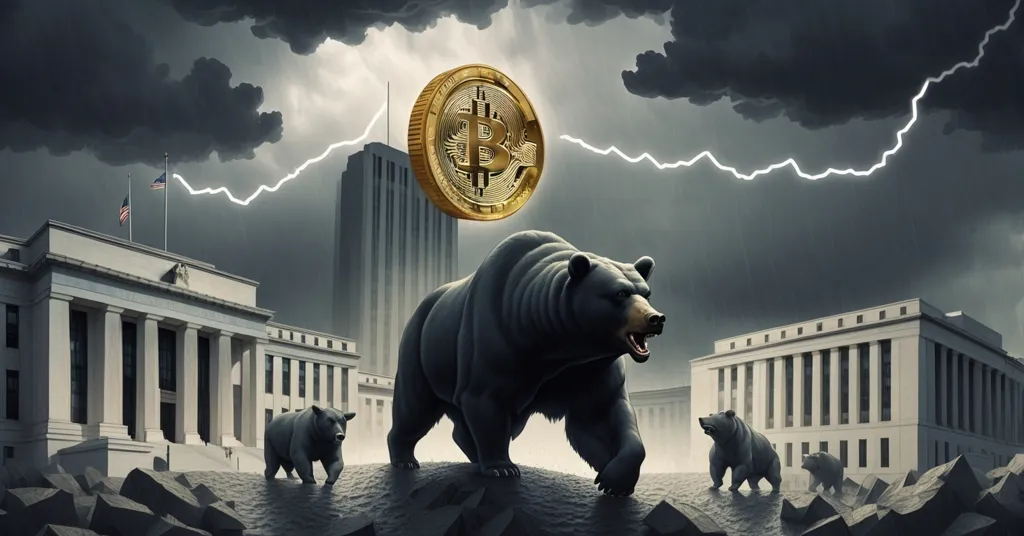Bitcoin Sentiment Turns Bullish as Fed Rate Decision Looms Over $114K Price

Bitcoin Price Sentiment Shifts: Bull-Bear Index Turns Positive Amid Fed Rate Decision
Bitcoin is clinging to stability above $113,000, with the crypto world holding its breath for the Federal Reserve’s interest rate decision this Wednesday—a make-or-break moment that could either catapult BTC to new heights or trap it in a frustrating rut. Amid this tension, a critical market metric, the Bitcoin Bull-Bear Structure Index, has turned positive for the first time since October 12, hinting at burgeoning buyer momentum.
- Bitcoin trades near $114,400, locked between $113K and $115K in consolidation.
- Bull-Bear Structure Index signals bullish momentum with a positive shift.
- Fed’s rate decision looms as a critical driver for Bitcoin and risk asset markets.
Bitcoin’s Price Standoff: A High-Stakes Waiting Game
Right now, Bitcoin (BTC) hovers around $114,400, stuck in a tight range of $113,000 to $115,000. This consolidation isn’t just a pause—it’s a battlefield of uncertainty as traders await macroeconomic clarity. The stakes couldn’t be higher with the Federal Reserve set to announce its interest rate stance on Wednesday. For the uninitiated, a dovish policy—favoring lower interest rates to spur economic growth—could push capital out of low-yield assets like bonds and into riskier bets like Bitcoin. On the other hand, a hawkish approach, tightening rates to curb inflation, might keep BTC mired in this sideways slog or even drag it down to key support levels like $111,000.
Bitcoin’s price isn’t merely a number on a screen; it’s a real-time reflection of sentiment, speculation, and the tug-of-war between decentralized ideals and legacy financial systems. Despite operating on a censorship-resistant blockchain, BTC remains sensitive to central bank moves—a bitter irony for those of us championing financial sovereignty. This Fed decision could very well dictate whether Bitcoin breaks free or stays tethered to traditional finance’s whims for another cycle.
Sentiment Metrics: Are Bulls Finally Taking Charge?
Amid the price indecision, market sentiment is showing flickers of optimism. The Bitcoin Bull-Bear Structure Index, a nuanced gauge that blends price trends with on-chain data—think transaction volumes and wallet movements recorded directly on Bitcoin’s blockchain—has shifted above zero for the first time since October 12. Analyst Axel Adler has pointed out this change as a sign that buyer momentum may be building after weeks of balance, as detailed in a recent market analysis.
The Bitcoin Bull-Bear Structure Index moving above zero for the first time since October 12 suggests momentum may be tilting in favor of buyers.
For those new to the term, on-chain data offers a transparent window into Bitcoin’s network health, revealing how much BTC is being moved, held, or accumulated. A positive index reading isn’t a golden ticket to the moon, but it’s a compelling hint that underlying dynamics are leaning bullish. Historically, similar shifts have preceded rallies, as seen post-2020 halving when sentiment turned ahead of Bitcoin’s climb to $69,000—though past performance is never a guarantee.
Reinforcing this cautious optimism is the Bitcoin Unified Sentiment Index, which pulls from community feedback like CoinGecko’s up/down votes and the Fear & Greed Index—a barometer of investor psychology ranging from panic to euphoria. This index has also tipped into positive territory, suggesting growing confidence. Sentiment often acts as a leading indicator in crypto; when traders feel bullish, they position for gains, sometimes sparking self-fulfilling momentum. But let’s keep the champagne on ice—sentiment in this space can reverse quicker than a rug pull on a shady altcoin, especially with macro headwinds still in play.
Bitcoin Price Analysis: Key Technical Levels to Watch
Looking at the charts, Bitcoin is laying the groundwork for a potential breakout, though hurdles remain. It has reclaimed its 50-day moving average, a short-term trendline traders use to assess momentum—imagine it as a rolling average of the past 50 days’ prices to filter out daily noise. It’s also holding support at the 200-day moving average, a longer-term measure of market health. These developments are encouraging, but a formidable barrier lies at $117,500 resistance. Break through, and we could see BTC targeting $120,000 or even $125,000—a level that’d have maximalists toasting to fresh highs. Stumble, and a retreat to $111,000 support, or a deeper drop to $107,000, isn’t out of the question.
For newcomers, these technical levels are more than just lines—they’re psychological flashpoints where buying and selling pressures collide. Smashing resistance often ignites FOMO (fear of missing out), while cracking support can trigger panic sales. Keep your eyes glued to $117,500; it’s the linchpin for Bitcoin’s next major move. Beyond averages, on-chain metrics like whale accumulation—large investors stockpiling BTC—add weight to the bullish setup, with recent data showing steady inflows to long-term holder wallets, a sign of confidence at current levels.
Market Backdrop: Stablecoin Liquidity and On-Chain Resilience
Zooming out from price action, broader market conditions are aligning to potentially bolster Bitcoin. Stablecoin liquidity—the pool of fiat-pegged tokens like USDT and USDC available for trading—is near cycle highs. Think of this as cash reserves sitting on exchange sidelines; high liquidity means there’s plenty of fuel to ignite BTC’s price if the right spark, like a dovish Fed, comes along. We’ve seen this before—late 2020’s stablecoin surge preceded Bitcoin’s historic run to $69,000, though we’re not at those euphoric levels just yet.
On-chain activity, while not screaming “to the moon,” remains stable. Metrics like exchange inflows and outflows (how much BTC moves to or from trading platforms) suggest neither mass selling nor buying frenzy—just a steady hum of network strength. Unlike fleeting altcoin pumps, Bitcoin’s value shines through its battle-hardened blockchain, a decentralized bastion against fiat erosion. This resilience, paired with liquidity, paints a constructive picture—assuming no macro curveballs.
The Macro Wildcard: Fed’s Role and Global Risks
The Federal Reserve’s decision is the 800-pound gorilla here, but it’s not the sole macro factor at play. A dovish pivot—keeping or cutting rates—could send Bitcoin soaring as investors chase riskier assets over stagnant bonds. A hawkish or neutral stance, however, risks prolonging this consolidation or sparking a correction. Beyond the Fed, global uncertainties loom large: economic slowdowns, unexpected inflation spikes, or geopolitical chaos (think escalating tensions in key regions) could torpedo even the most bullish setups. Then there’s the regulatory specter—a tighter monetary policy often fuels calls for stricter U.S. crypto oversight, layering on additional risk.
This macro ripple effect isn’t Bitcoin-exclusive. Ethereum (ETH), with staking yields mimicking interest rates, could see correlated movement, while stablecoin usage in DeFi (decentralized finance) protocols might surge if liquidity hunts for returns. As a Bitcoin maximalist, I’ll always argue BTC is the ultimate defiance of centralized control, but I can’t ignore that altcoins like ETH carve out vital niches—smart contracts, programmable finance—that Bitcoin doesn’t aim to tackle. The Fed’s decision will test the entire crypto market’s mettle, not just the king.
Counterpoints: Why Bitcoin’s Bullish Signals Could Fizzle
Let’s cut through the optimism with some hard-nosed skepticism. Sure, the Bull-Bear Index and sentiment upticks look promising, but they’re no ironclad promise of a rally. Bitcoin has a brutal history of building false hope before slashing dreams—take May 2021, when rosy sentiment crumbled into a 50% crash after Tesla dumped BTC payments and China doubled down on mining bans. Macro unpredictability is a constant threat, and speculative froth often trails sentiment spikes. You’ll see clowns on social media hawking “$200K by year-end!” nonsense—utter garbage. We’re not peddling fairy tales here. Bitcoin’s true worth lies in its decentralized, un-censorable nature as a store of value, not as some Vegas slot machine. Ignore the shills; they’re likely offloading bags to naive retail traders.
Even on-chain strength can mislead. High stablecoin liquidity could just as easily fund a mass exit if sentiment sours, and whale accumulation doesn’t always mean price pumps—sometimes it’s just repositioning before a dump. Add in potential regulatory crackdowns tied to Fed tightening, and the bullish case starts looking shakier. Bitcoin’s long-term disruption potential is undeniable, but short-term hype? Take it with a truckload of salt.
Key Takeaways and Critical Questions on Bitcoin Trends
- What does the Bull-Bear Structure Index turning positive mean for Bitcoin investors?
It points to rising buyer momentum via price and on-chain data, suggesting a bullish tilt since October 12 after a period of indecision. - How could the Federal Reserve’s rate decision shape Bitcoin’s path?
A dovish policy with lower or stable rates might trigger a BTC rally by funneling capital into risk assets, while a hawkish or neutral tone could stall momentum or cause a dip. - What are the critical Bitcoin price levels to monitor?
Resistance at $117,500 is pivotal for a potential surge to $120K–$125K, with support at $111K and a deeper base at $107K if bears take control. - Why is market sentiment leaning toward optimism?
The Unified Sentiment Index, blending CoinGecko votes and the Fear & Greed Index, reflects growing confidence, likely spurred by stable on-chain activity and Fed anticipation. - Which broader factors could support a Bitcoin rally?
High stablecoin liquidity and steady on-chain metrics like whale accumulation create a promising setup for gains, barring major macro disruptions. - Could macro or regulatory risks undermine Bitcoin’s positive signals?
Absolutely—global economic woes, inflation surprises, or tighter U.S. crypto rules linked to Fed policy could overshadow bullish sentiment and technical setups.
Final Reflections: Bitcoin’s Tug-of-War with Legacy Systems
Stepping back, this week feels like a defining juncture for Bitcoin. The clash of sentiment shifts, technical indicators, and macroeconomic forces highlights both the progress of crypto and its lingering ties to traditional finance—a frustrating dance for decentralization advocates like myself. I’m rooting for BTC to snap these legacy chains and stand as the ultimate beacon of financial freedom, regardless of short-term Fed outcomes. Whether we’re on the brink of a breakout or stuck in another maddening consolidation, Bitcoin’s enduring strength and the sophistication of its market metrics solidify its reign as the cornerstone of this financial uprising. Altcoins like Ethereum play their part, innovating in realms BTC sidesteps, but when it comes to pure, unfiltered disruption, nothing matches the original. So, will Bitcoin finally shrug off central bank shadows, or are we fated to sway to their rhythm for another market cycle?



